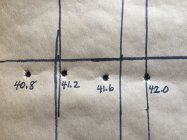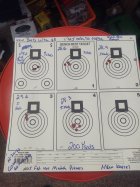CaptJim
Silver $$ Contributor
I know 300yds would be better and show more of a spread but only the 100 yd range was accessible and I had read Eric Cortina's article about this so I thought I would try it at 100.
Would like to receive guidance on this first attempt at a ladder test with my .308
I shot 10 rounds, one round at each charge wt. starting at 40.8 gr and ending at 44.4 gr. in .4 gr steps. The aiming point was on the horizontal line in each case. This was with 155gr Scenars in new Lapua Palma brass, Win small rifle primers and Shooter's World Precision Rifle as a Varget clone.
The vertical spread is small, but looks like 40.8 to 42.0 gr may be a node; as well as 42.8 to 43.2 for lower nodes. I didn't load any higher than 44.4, but I feel sure there may be another higher one.
Thanks for any info,
CJ



Would like to receive guidance on this first attempt at a ladder test with my .308
I shot 10 rounds, one round at each charge wt. starting at 40.8 gr and ending at 44.4 gr. in .4 gr steps. The aiming point was on the horizontal line in each case. This was with 155gr Scenars in new Lapua Palma brass, Win small rifle primers and Shooter's World Precision Rifle as a Varget clone.
The vertical spread is small, but looks like 40.8 to 42.0 gr may be a node; as well as 42.8 to 43.2 for lower nodes. I didn't load any higher than 44.4, but I feel sure there may be another higher one.
Thanks for any info,
CJ
















